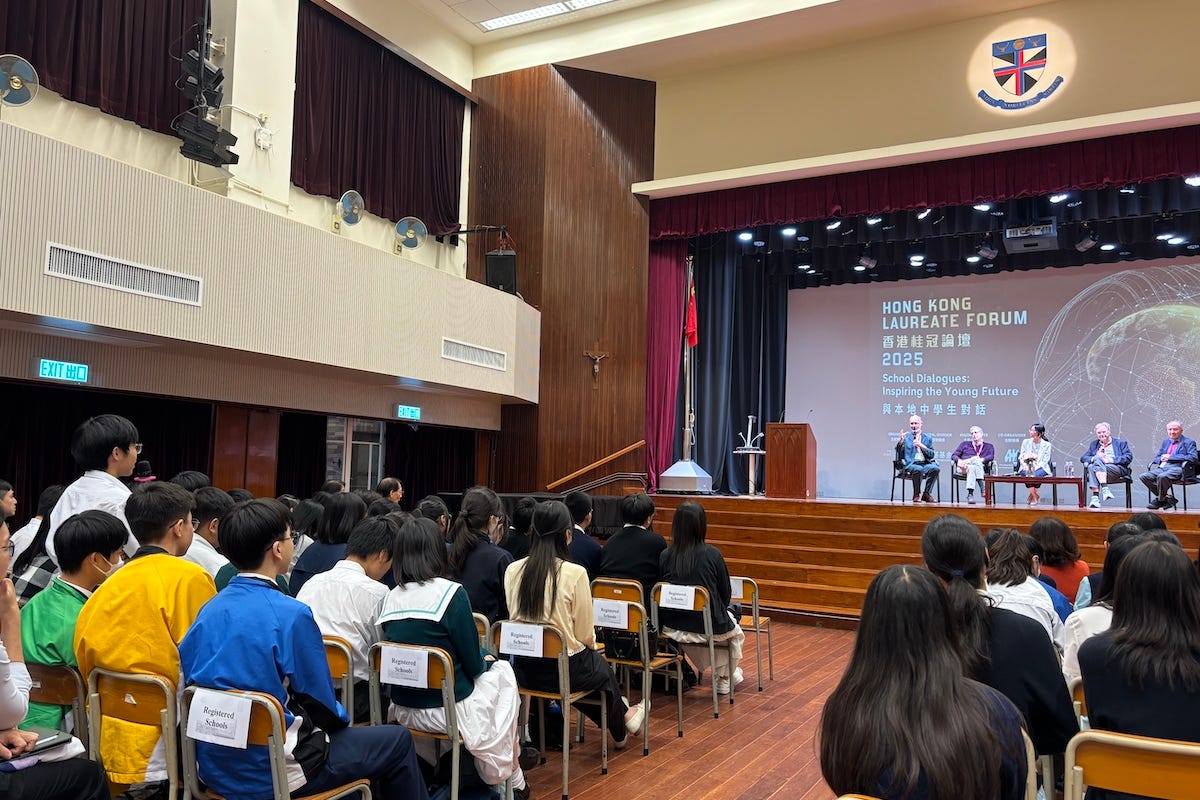Six Questions Hong Kong Students Put to Renowned World‑Class Scientists
Bright young students engaged Shaw Laureates with detailed questions on cosmos, cells, and equations during an inspiring Hong Kong school visit
About 200 Hong Kong secondary-school students gathered at Maryknoll Convent School on November 7, where they had the precious opportunity to engage in an in-depth dialogue with four Shaw Laureates.
The four included John Peacock, Professor of Cosmology at the University of Edinburgh; Steven Balbus, Savilian Professor of Astronomy at the University of Oxford; Wolfgang Baumeister, Director and Scientific Member of the Max Planck Institute of Biochemistry; and George Lusztig, Abdun‑Nur Professor of Mathematics at the Massachusetts Institute of Technology. Each of them shared personal insights into their research journeys, scientific challenges, and motivations.
Designed to inspire young scientific minds, the session encouraged students to ask bold, technically informed questions. The exchanges that followed revealed a striking level of curiosity and analytical thinking, as students pressed the laureates on topics ranging from dark matter to protein misfolding and the nature of scientific breakthroughs.
The school visit was part of the 2025 Hong Kong Laureate Forum, held in Hong Kong from November 5–8, 2025.
Sponsored by the Lee Shau Kee Foundation, the Forum aims to foster meaningful dialogue between distinguished scientists and younger generations, encouraging students to pursue curiosity‑driven research and broader scientific understanding.
During the school visit, the students raised six questions:
1. Question on misfolded proteins (to Baumeister)
Student: Can your scientific discovery help in understanding diseases involving misfolded proteins, such as Alzheimer’s or other neurodegenerative disorders?
Baumeister: “If proteins become misfolded or unstable, they form aggregates inside cells, and these aggregates interact in a destructive manner with the cell environment. Some of these aggregates damage membranes, while others attract the machinery of protein degradation, so it becomes inactivated. The method allows us to study the architecture of cells in a healthy state, but also in a disease state, and cryo‑electron tomography now enables us to visualise toxic protein structures directly.”
2. Question on gravitational lensing and dark matter (to Peacock & Balbus)
Student: An article described a system showing five images instead of four in a gravitational lens. How is this possible, and does it relate to dark matter?
Peacock: “Massive bodies should make light fall in the same way as they make material fall. Gravitational lenses create multiple images because each light path arrives at a different time, and one image can be missing if the source is variable. By the amount of distortion, you can see how massive the foreground object is. The galaxies cause more lensing than they should from the material we can see. Dark matter has to exist.”
Balbus: “Gravitational lensing is one of the best ways to find dark matter.”
3. Question on accretion-disk instability (to Balbus)
Student: How did you prove that magnetism was the force causing instability in accretion disks, rather than tidal forces or other effects?
Balbus: “I didn’t know that magnetism was responsible. I had seen magnetic fields behave unexpectedly in other problems, so I put them in from the start. You can’t ignore the magnetic field and then put it back in later. The inner gas loses angular momentum and falls inward; the outer gas gains angular momentum and goes outward. Once the spring is stretched, the force gets stronger, and the transfer goes faster. This runaway process creates turbulence and accretion. Something unexpected dropped out.”
4. Question on mathematics and real-life applications (to Lusztig)
Student: How does your mathematical work relate to real-world applications?
Lusztig: “Most of the things we do do not apply. One in a hundred years is so important that it justifies all the previous time. My work on total positivity turned out to be very important for physics. A lot of things in mathematics are useless, but one in a hundred years is so important that it justifies all the previous time when it was useless. I am interested in the study of symmetries. It is a bit more difficult to explain exactly what I am doing.”
5. Question on the impact of winning the Shaw Prize (to all laureates)
Student: How has receiving the Shaw Prize affected your research or career?
Peacock: “The prize has not changed my direction. When you achieve a bit of success, you expect a little more of yourself.”
Balbus: “It made my name a little more recognizable. It helps with things like grant applications. But it also gave me a sense of responsibility, because what I thought was playing around with equations suddenly turned out to matter.”
Baumeister: “Over 30 years, probably a hundred graduate students and postdocs were involved. It’s a recognition for the entire team.”
Lusztig: “I don’t think it changed anything in what I was doing. Some people stop working after a big prize—I hope I am not in that category.”
6. Question on preparing for success (to all laureates)
Student: How did you prepare yourself for the breakthrough moments that led to major discoveries?
Peacock: “Success comes as an unexpected coming together of things that don’t seem to fit.”
Balbus: “I never spent a moment preparing to handle success. I was driven by fascination. You really have to be extremely taken with your work.”
Baumeister: “All good science is driven by curiosity. It can be fun to delve into the unknown, even though there are frustrations.”
Lusztig: “Sometimes I get stuck, but after I sleep, I find how to continue.”
The four Shaw Laureates also visited the school’s science laboratories, where students introduced their ongoing experiments and demonstrated their research projects. The interaction provided the laureates with a closer look at how young learners engage with scientific inquiry at an early stage.




